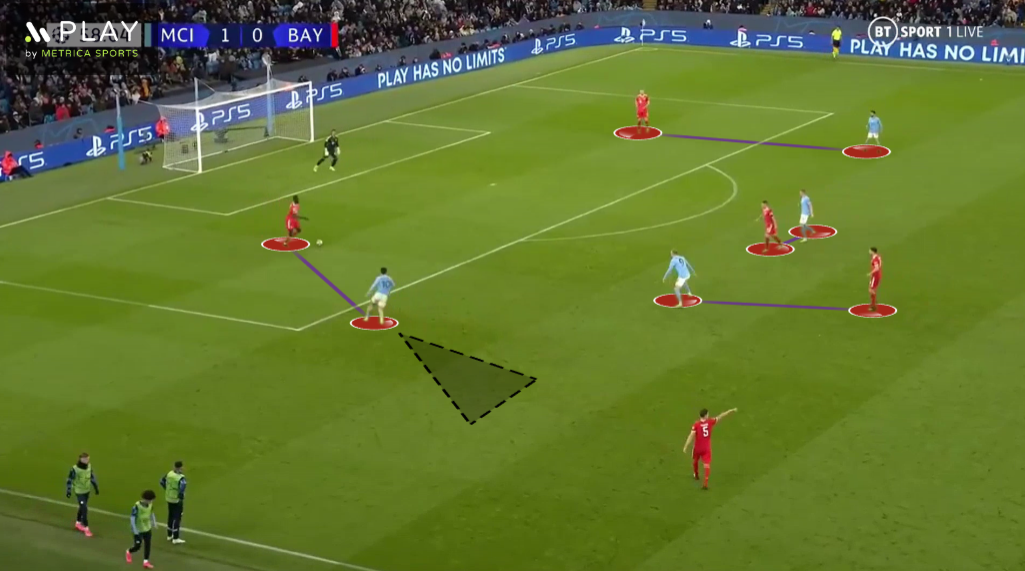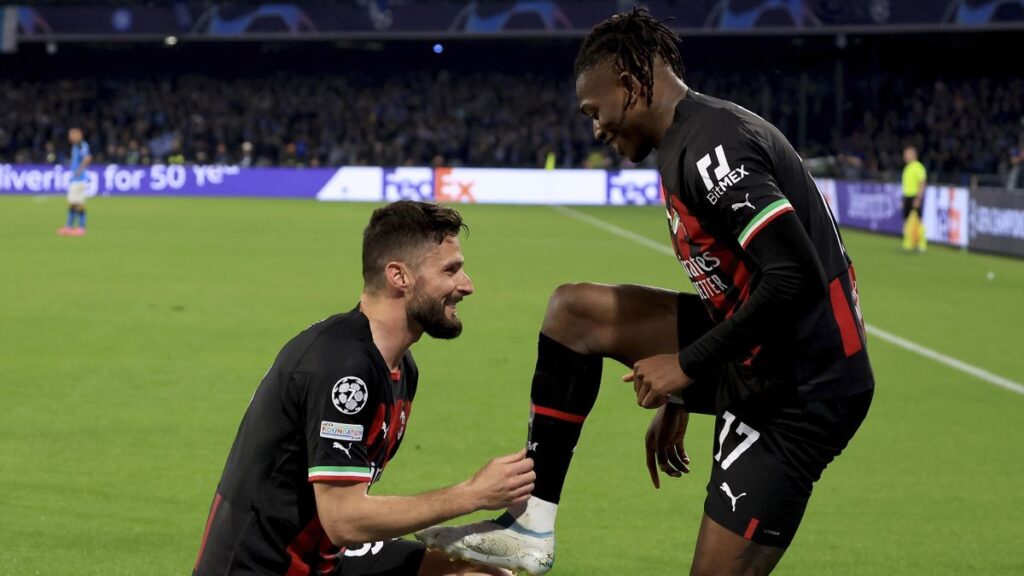In the Champions League match described as an "early final", Manchester City faced Bayern Munich in their home stadium. As expected, the two teams displayed a great tactical battle, but the Bayern players' individual mistakes ultimately made their mark on the game. Thomas Tuchel was also disappointed in his first Champions League match in charge of the Bayern team. The starting 11s of the two teams in the big match were as follows:

MANCHESTER CITY IN POSSESSION
Manchester City didn't look as comfortable during the build-up as in other matches and this was reflected in the statistics (Build-up completion: 83.9%). Of course, Thomas Tuchel's pressing style had a lot to do with this. The German coach did what no other team in the league could do and found a solution to Manchester City's 3-2 structure at the back, but still couldn't prevent the opponent from scoring 3 goals. When Bayern Munich started applying pressure high up the pitch, goalkeeper Ederson acted as a left centre-back and contributed to the build-up. In Bayern Munich's case, the player who was positioned highest up the pitch directed the centre-back with the ball towards the flank. Meanwhile, the player in the number 10 position marked the opponent's ball-near pivot, while the ball-far pivot was left free. Manchester City were thus directed to the flank and the home team were forced to play long.

Ederson acts as a left centre-back. With the use of the 3rd man, the ball reaches R. Dias, who is open

Gnabry blocks R. Dias' passing lane to the right side of the pitch and directs the Portuguese to the flank

This creates a 3v3 match-up on the wing and Ake is forced to play long
When Manchester City moved the ball into the second third, Stones moved out from the centre-back area to join Rodri and with Akanji coming inside, the 3-2-2-3 structure was formed. The advantage of Stones shifting from the centre-back area to Rodri, rather than from the right-back area as in previous games, was that he could change positions quickly.

Manchester City's 3-2-5 formation
THE IMPORTANCE OF GNABRY AND MUSIALA DURING THE PRESS
The away team, on the other hand, faced their opponents with a narrow 4-2-3-1 formation. In the midfield, Kimmich and Goretzka matched-up with Ilkay and De Bruyne, and the wingers with the opposition's wide centre-backs (Ake-Akanji). Gnabry and Musiala's correct movement during pressure was of great importance here. During the press, Striker Gnabry cut off R. Dias' passing lane with the ball-far pivot. Musiala, meanwhile, closely marked the ball-near pivot, making it impossible for City to penetrate through the center.

Gnabry applies cover shadow on Rodri while also applying pressure on R. Dias. Musiala, meanwhile, closely marks Stones

The match-ups in the midfield can be seen here clearly: Goretzka-Ilkay, Kimmich-Alvarez

Gnabry blocks R. Dias' passing lanes with the left side of the pitch. On the opposite flank, pivot Rodri is left free, while Stones is marked by Musiala. Meanwhile, Bayern's 3-1 formation up high is pretty narrow

When Akanji receives the ball, this time Sane applies pressure and the opponent is forced to play long
KDB AND ILKAY DURING THE BUILD-UP
In comparison, De Bruyne and Ilkay, at times positioned themselves wide to escape the marking of Kimmich and Goretzka, in order to break the opposition's pressure. On other occasions, the City players used diagonal passes to reach the winger positioned on the opposite flank.

Ilkay shifts towards the wing from the center to escape Kimmich's marking and receives Ake's pass. With Kimmich moving towards Ilkay, space opens up in the center and Manchester City build-up from the center

In this situation, we see KDB positioning himself wide as the ball is received by Akanji

On the left wing, Ilkay and Grealish have a 2v1 numerical advantage over Pavard. Ilkay lures Pavard into the center with his decoy-run and creates space for Grealish. R. Dias sees this and plays a diagonal pass towards Grealish
BAYERN MUNICH IN POSSESSION
Although Bayern Munich had more possession throughout the match, they didn't have as many clear scoring chances as their opponent and didn't use the ball effectively enough. In the second half, the Bayern players (after some individual mistakes) lost control. When the Manchester City players started the pressure immediately after the opponent's goal kick, they matched up with the Bayern players 1v1. The Bavarians, on the other hand, tried different build-up strategies against the opponent's 4-4-2 press. One of them was for Kimmich to get between the centre-backs. This would give them a 3-2 numerical advantage at the back and a 5-4 advantage in midfield if Gnabry and Musiala were involved in the 2. line.

City's 4-4-2 pressing formation and the resulting match-ups. If Musiala drops deep from the front line, Stones follows him

With Kimmich dropping deep, Bayern have a numerical advantage at the back. Goretzka is joined by Gnabry and Musiala. This creates a 5v4 advantage in midfield (with the fullbacks also positioned wide)
Bayern Munich's main plan was to draw City to themselves and create space behind for the front 4. When the centre-backs had the ball, Coman and Sane would provide depth, Gnabry would position himself in the right half-space and Musiala in the left half-space, thus creating a 4-2-4 structure. Sane started the match on the left and Coman on the right, meaning that both players could drop behind the defense in a possible transition attack and cross with their strong feet. After the first goal, these two players swapped places. From then on, they dribbled inside when they had the ball at their feet (as they are opposite-footed), opening up space for the full-backs to overlap. Leroy Sane was particularly effective towards the end of the first half, moving the ball inside and shooting from distance. Ake and Akanji did a good job, even if both of these players were quite talented in terms of eliminating players during 1v1 situations. At the start of the 2nd half, Tuchel reverted back to his main plan and these two players started to get behind the defense again (rather than trying to get the ball at their feet).

Coman and Sane provide width and depth, while Gnabry and Musiala are positioned between the lines. The aim is to get the ball to these players and create a transition

After the first goal, Coman and Sane started to play on opposite wings. In this situation, Coman receives the ball and dribbles the ball inside. A. Davies overlaps into the space created
BERNARDO'S ROLE DURING THE PRESS
Pep Guardiola used two different forms of pressing in the first and second half. In the first half, the Bayern Munich centre-backs were not under much pressure and could reach the fullback on the opposite side. In the second half, Guardiola instructed his team to press in a similar style to the one used against Leipzig. Haaland and KDB pushed up against the opponent's 2 pivots, while Bernardo and Grealish (with the opponent's full back behind them) went to apply pressure on the centre-back. Although it was a risky approach, the work rate of Bernardo in particular made City's job a lot easier and the hosts had no problems. It reminded me of what Guardiola said about Bernardo after the Leipzig game:
I play Bernardo [Silva] because the left side for Leipzig is incredible. He has ability to press three players in one movement. Not one player in the world can do it

City's pressing shape in the first half. One of the players from the KDB-Haaland duo applies pressure on the centre-back who has the ball, while the other marks the ball-far pivot. The winger on the opposite flank pushes up against the other centre-back. Rodri/Ilkay mark the free pivot

When the winger on the opposite flank applies pressure on the centre-back who doesn't have the ball, the full-back is left free. In the first half, Bayern Munich had little trouble reaching this free player

In the 2nd half, Haaland-KDB mark the opposition's pivots while Bernardo-Grealish apply pressure on the centre-back (they also apply cover-shadow on the full-back). Although 2 fullbacks were left free in such situations, Bayern could not take advantage of it due to the work rate of the wingers

City scored their 2. goal thanks to this type of pressure. Grealish blocks Upamecano's passing lane to Pavard and intercepts. After that Manchester City doubles the lead
When the away team settled in the final third, they attacked in a similar structure to the structure they used during the build-up. The wingers provided width, with Gnabry and Musiala provided passing options between the opposition's 1st and 2nd lines. Manchester City, on the other hand, countered the opposition in a 4-4-2 formation in their own defensive third.

Bayern Munich's 2-4-4 formation and Manchester City's 4-4-2 structure in the defensive third
Conclusıon
In the tactical battle between Pep Guardiola and Thomas Tuchel, Manchester City were the winning side . Not every team can prevent City's 3-2 formation at the back from building up play, but Tuchel managed to make it very difficult for his opponent. We don't know what the 2nd game of the round will bring, but City have a huge advantage. We should also mention that Bayern Munich didn't start the game that badly, but after Rodri's goal they couldn't react at all. Especially after individual mistakes, the Bayern players were not at their best mentally and City took advantage of that. Let's see if Tuchel can use City's pressing style to his advantage in the 2nd leg in Munich.



